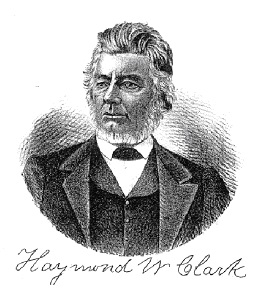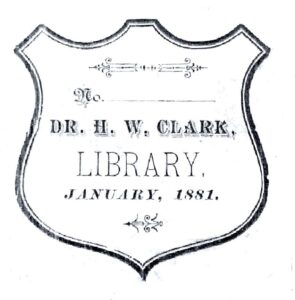History of Hamilton East Public Library: Dr. Haymond W. Clark
By: David Heighway, Hamilton County Historian
 Of the two men who rescued the library after the Civil War, Dr. Clark was the most significant. Haymond William Clark was born in what is now West Virginia in 1803. He came to Indiana in 1819 and apprenticed himself to a doctor in Connersville. He received his license to practice medicine in 1827 and moved to Noblesville the same year. He was probably the second doctor to work in Hamilton County and kept his practice open until 1869 when he retired from active work. He was a founding member of the Hamilton County Medical Society in 1873 and represented the Indiana State Medical Society at the American Medical Association in 1874 and 1877. Besides his medical work, he also held several county offices, was a member of the state legislature in 1843, was part of the Indiana Constitutional Convention in 1850, and was Probate Judge from 1844 to 1852. He and his wife Cassandra had eight children.
Of the two men who rescued the library after the Civil War, Dr. Clark was the most significant. Haymond William Clark was born in what is now West Virginia in 1803. He came to Indiana in 1819 and apprenticed himself to a doctor in Connersville. He received his license to practice medicine in 1827 and moved to Noblesville the same year. He was probably the second doctor to work in Hamilton County and kept his practice open until 1869 when he retired from active work. He was a founding member of the Hamilton County Medical Society in 1873 and represented the Indiana State Medical Society at the American Medical Association in 1874 and 1877. Besides his medical work, he also held several county offices, was a member of the state legislature in 1843, was part of the Indiana Constitutional Convention in 1850, and was Probate Judge from 1844 to 1852. He and his wife Cassandra had eight children.
He was called “eccentric” by most of those that knew him. Long after the pioneer era ended in Hamilton County, he preferred to dress in jeans breeches and homespun shirts. Although he was wealthy, the only time he would wear a suit would be twice-yearly business trips to Cincinnati. He never used a buggy and always rode a horse. Later, as the town grew, he kept moving his house and doctor’s office just outside the corporate limits. Despite these quirks, he was highly respected as a doctor, both for his skill and his reasonable charges. Residents said that, although he appeared brusque and very set in his opinions, he was actually a likable person. Most importantly, he was considered a “Free Thinker”.
The Doctor’s iconoclastic ideas probably came from his extensive reading. As a young man, he had wanted a good library of his own, and as he grew older, he began collecting books. By the 1870’s, it was estimated that he had close to 1,000 books in his personal library. Many of these were, of course, medical books. The rest were on a variety of subjects including history, science, and law, as well more specific topics such as temperance, city planning, political science, theater, and many others. For its time and place, it was an extraordinary collection. One historian said Dr. Clark had taught himself several foreign languages to expand his reading ability. Obviously the doctor considered reading to be an important part of a person’s life.
 He applied this belief to the community as well. When Dr. Clark died in September of 1880, he made his greatest contribution to the city library. In his will, he left an estimated 400 books to be added to the collection and to be called the Clark Library. His bookplate inside the front cover identified Clark’s books. One book, The Dramatic Works of Richard Brinsley Sheridan, had Clark’s signature on the title page, (published in 1852, it was in the library circulating collection until 2002). The rest of his books were left to the Central College of Physicians and Surgeons in Indianapolis, which is now the Ruth Lilly Medical Library at IUPUI. The Ladies Aid Society took over running the reading room in Noblesville, added some other personal collections, and Miss Marian Lindsay became the first librarian. She was paid $1.25 a week. Subscriptions to the library were $1.00 a year for a family, and the books were housed on the second floor of a building on Catherine Street (now Ninth), just south of the square.
He applied this belief to the community as well. When Dr. Clark died in September of 1880, he made his greatest contribution to the city library. In his will, he left an estimated 400 books to be added to the collection and to be called the Clark Library. His bookplate inside the front cover identified Clark’s books. One book, The Dramatic Works of Richard Brinsley Sheridan, had Clark’s signature on the title page, (published in 1852, it was in the library circulating collection until 2002). The rest of his books were left to the Central College of Physicians and Surgeons in Indianapolis, which is now the Ruth Lilly Medical Library at IUPUI. The Ladies Aid Society took over running the reading room in Noblesville, added some other personal collections, and Miss Marian Lindsay became the first librarian. She was paid $1.25 a week. Subscriptions to the library were $1.00 a year for a family, and the books were housed on the second floor of a building on Catherine Street (now Ninth), just south of the square.
As years passed and the library changed, the Clark Library eventually became part of the regular collection. The books would be treated like all the others and discarded when they wore out or were damaged beyond repair. By 1910, there were only 144 of them left in the collection. It would be natural to assume that these books have long since disappeared. However, there are five of them still in the regular collection of the Hamilton East Public Library. The oldest book is a three-volume set called Observations on the Popular Antiquities of Great Britain by John Brand, published in 1853. An interesting book is The Great Indian Chief of the West, or, Life and Adventures of Black Hawk by George Conclin, published in 1858. Since the Black Hawk War was in 1832 and Black Hawk himself died in 1838, this is a very contemporary biography. The other three books are: The Colonial History of Vincennes, Under the French, British, and American Governments by John Law, published in 1858; Footfalls on the Boundary of Another World by Robert Dale Owen, published in 1860; and Recollections of the Early Settlement of the Wabash Valley by Sandford C. Cox, published in 1860. While they are actually worth little from a financial standpoint, the survival of these volumes is a unique occurrence. Over the years, the Noblesville library has received a variety of generous gifts. However, there are probably few that excel the one given by Dr. Haymond W. Clark. Like Thomas Jefferson and the Library of Congress, the donation of Dr. Clark’s personal collection of books in 1880 assured both the growth and continuation of a city library in Noblesville.
